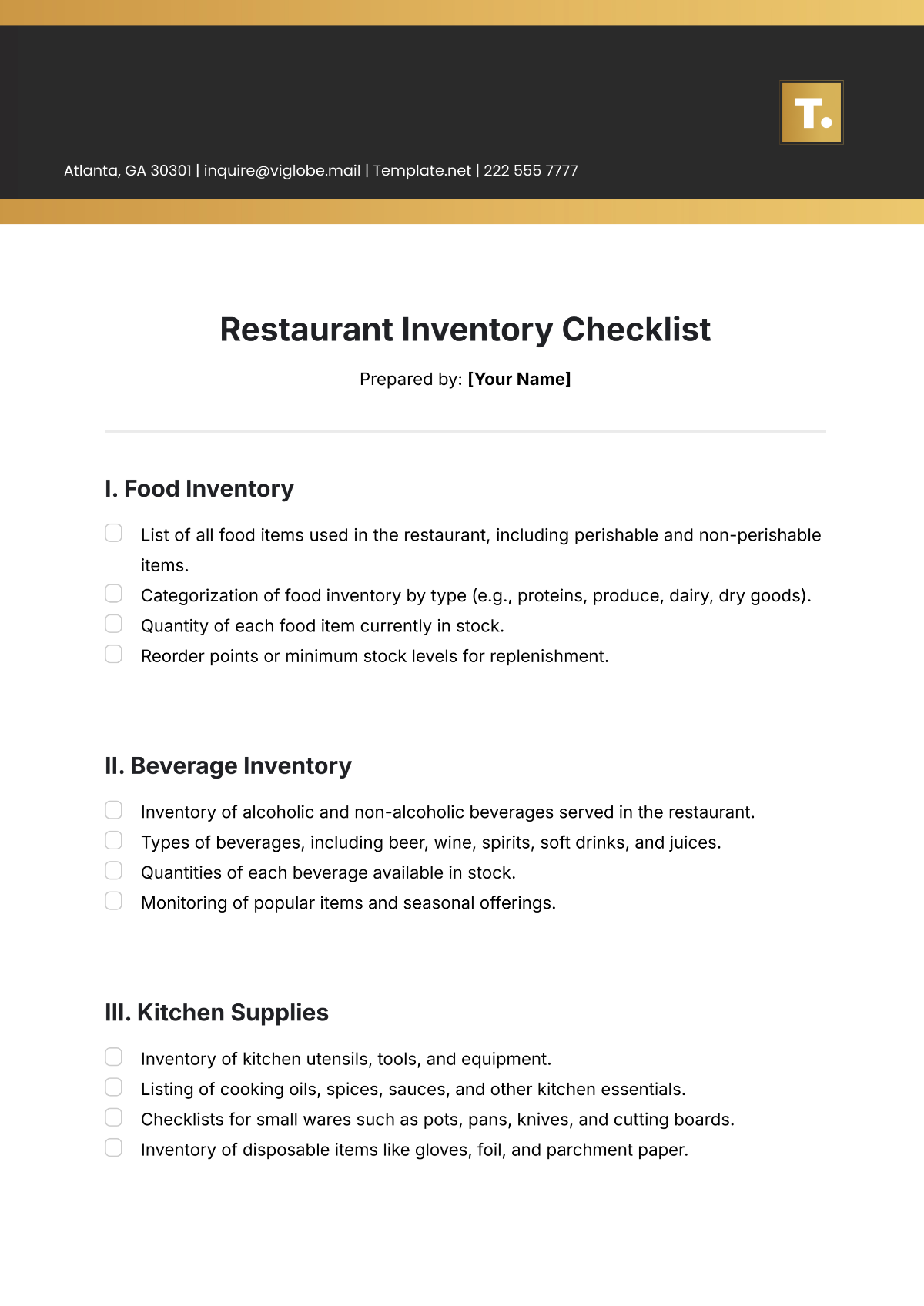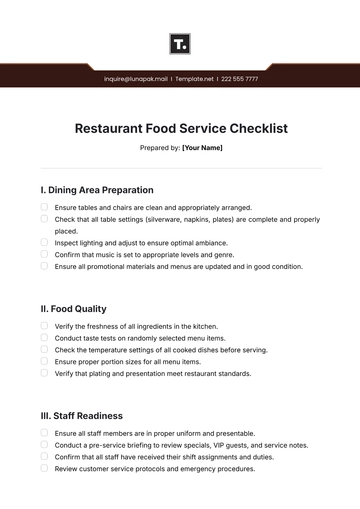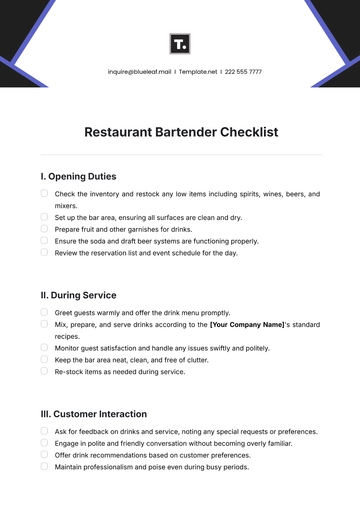Free Restaurant Inventory Checklist

Prepared by: [Your Name]
I. Food Inventory
List of all food items used in the restaurant, including perishable and non-perishable items.
Categorization of food inventory by type (e.g., proteins, produce, dairy, dry goods).
Quantity of each food item currently in stock.
Reorder points or minimum stock levels for replenishment.
II. Beverage Inventory
Inventory of alcoholic and non-alcoholic beverages served in the restaurant.
Types of beverages, including beer, wine, spirits, soft drinks, and juices.
Quantities of each beverage available in stock.
Monitoring of popular items and seasonal offerings.
III. Kitchen Supplies
Inventory of kitchen utensils, tools, and equipment.
Listing of cooking oils, spices, sauces, and other kitchen essentials.
Checklists for small wares such as pots, pans, knives, and cutting boards.
Inventory of disposable items like gloves, foil, and parchment paper.
IV. Dining Room Supplies
Inventory of dining room essentials such as dinnerware, glassware, and flatware.
Monitoring of linens, napkins, tablecloths, and cleaning supplies.
Listing of condiments, salt and pepper shakers, and other tableside items.
Checklists for guest amenities like menus, reservation books, and payment terminals.
V. Cleaning and Sanitation Supplies
Inventory of cleaning chemicals, detergents, and sanitizers.
Tracking of cleaning tools and equipment such as brooms, mops, and buckets.
Checklists for restroom supplies like hand soap, paper towels, and toilet paper.
VI. Storage and Organization
Monitoring of storage areas including walk-in refrigerators, freezers, and dry storage.
Organization of inventory shelves, racks, and bins for easy access and retrieval.
Checklists for labeling, dating, and rotating stock to prevent waste and spoilage.
VII. Vendor and Supplier Information
Contact details for vendors and suppliers of restaurant inventory items.
Pricing information, delivery schedules, and payment terms.
Records of purchase orders, invoices, and receipts for inventory transactions.
VIII. Inventory Management Systems
Integration with inventory management software or systems for automated tracking and reporting.
Barcode scanning, RFID tagging, or other technologies for efficient inventory control.
Analysis of inventory data to optimize ordering, minimize waste, and maximize profitability.
- 100% Customizable, free editor
- Access 1 Million+ Templates, photo’s & graphics
- Download or share as a template
- Click and replace photos, graphics, text, backgrounds
- Resize, crop, AI write & more
- Access advanced editor
Optimize your restaurant inventory management with the Restaurant Inventory Checklist Template, exclusively offered by Template.net. This customizable, downloadable, and printable tool ensures meticulous tracking of stock levels and supplies. Effortlessly edit using our AI Editor Tool to tailor the checklist to your specific inventory needs. Simplify your inventory management for efficient operations and cost control.
You may also like
- Cleaning Checklist
- Daily Checklist
- Travel Checklist
- Self Care Checklist
- Risk Assessment Checklist
- Onboarding Checklist
- Quality Checklist
- Compliance Checklist
- Audit Checklist
- Registry Checklist
- HR Checklist
- Restaurant Checklist
- Checklist Layout
- Creative Checklist
- Sales Checklist
- Construction Checklist
- Task Checklist
- Professional Checklist
- Hotel Checklist
- Employee Checklist
- Moving Checklist
- Marketing Checklist
- Accounting Checklist
- Camping Checklist
- Packing Checklist
- Real Estate Checklist
- Cleaning Checklist Service
- New Employee Checklist
- Food Checklist
- Home Inspection Checklist
- Advertising Checklist
- Event Checklist
- SEO Checklist
- Assessment Checklist
- Inspection Checklist
- Baby Registry Checklist
- Induction Checklist
- Employee Training Checklist
- Medical Checklist
- Safety Checklist
- Site Checklist
- Job Checklist
- Service Checklist
- Nanny Checklist
- Building Checklist
- Work Checklist
- Office Checklist
- Training Checklist
- Website Checklist
- IT and Software Checklist
- Performance Checklist
- Project Checklist
- Startup Checklist
- Education Checklist
- Home Checklist
- School Checklist
- Maintenance Checklist
- Planning Checklist
- Manager Checklist
- Wedding Checklist
- Vehicle Checklist
- Travel Agency Checklist
- Vehicle Inspection Checklist
- Interior Design Checklist
- Backpacking Checklist
- Business Checklist
- Legal Checklist
- Nursing Home Checklist
- Weekly Checklist
- Recruitment Checklist
- Salon Checklist
- Baby Checklist
- Equipment Checklist
- Trade Show Checklist
- Party Checklist
- Hospital Bag Checklist
- Evaluation Checklist
- Agency Checklist
- First Apartment Checklist
- Hiring Checklist
- Opening Checklist
- Small Business Checklist
- Rental Checklist
- College Dorm Checklist
- New Puppy Checklist
- University Checklist
- Building Maintenance Checklist
- Work From Home Checklist
- Student Checklist
- Application Checklist





























